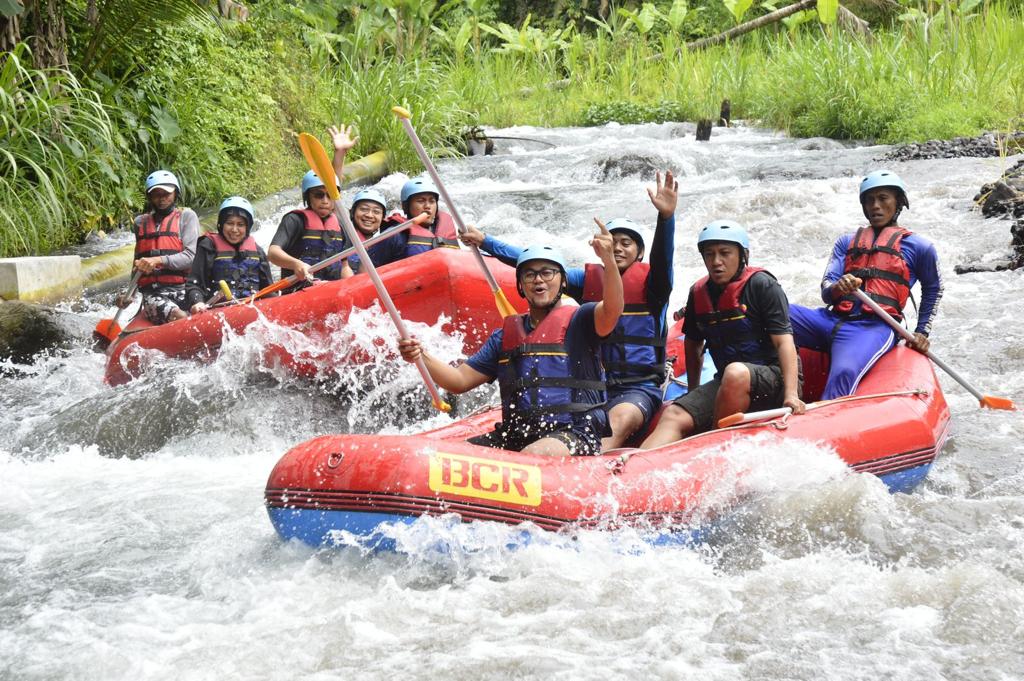Why Choose Telaga Waja Rafting?
Rafting is more than just a water sport, it is an exploration that provides an unforgettable experience. Racing on rapids, working together with a team, and enjoying the fantastic natural scenery are the special magnets of Telaga Waja rafting. In addition, Telaga Waja rafting offers various benefits, including:
- Improve physical health: Paddling challenging currents trains body muscles, increases ability and endurance.
- Reduce depression: Being in the outdoors and feeling the thrill of rafting can help reduce depression and improve mood.
- Create team collaboration: Telaga Waja rafting requires coordination and compact team collaboration to control the boat and get through obstacles.
- Increase optimism: Defeating rapids and obstacles on the river can increase optimism and courage.
- Add experience and past: Each rafting trip offers a unique experience and an unforgettable past.
4 Telaga Waja Rafting Equipment: The Key to Safety and Comfort
Before starting a rafting exploration, understanding the equipment needed is very important. The right equipment not only ensures comfort but also safety throughout the rafting. Here are the Telaga Waja rafting equipment that beginners must know:
1. Rubber Boat (Raft/Riverboats)
A special rubber boat for Telaga Waja rafting is designed to reduce collisions and maneuvers in river currents. This boat has important parts, namely:
- Bow and Stern: The front and back of the boat.
- Chamber/Tube: Air tube that surrounds the boat, providing buoyancy.
- Boat Floor: A place for several Telaga Waja rafting participants to step on.
- Thwart: A cylindrical cushion in the boat that acts as a foot support and additional seat.
- Boat Line: A rope that goes around the outside of the boat, used for grip and anchoring the boat.
- D-Ring: Metal ring on the body of the boat, where equipment or ropes are tied.
- Handling Grip: Handle on the outside of the boat to help lift and move the boat.
- Bilge Hole/Self Bailing: Hole in the floor of the boat to release incoming water.
- Valve: Place to fill and empty air in the chamber.
Seating Position: The way to sit on a Telaga Waja rafting boat is different from sitting on a bench. Participants sit sideways on the edge of the boat, either on the left or right, with their feet in a horse-drawn stance on the floor of the boat. This position is important to maintain balance throughout the rafting. Make sure no body parts are entangled or tangled in the rope, especially when the boat flips.
2. Life Jacket (PFD – Individual Floating Device)
Telaga Waja rafting life jacket
A life jacket, or PFD (Individual Floating Device), is safety equipment that must be worn by every rafting participant. PFD helps rafters stay afloat if they fall into the water. Type III PFD is the type commonly used in Telaga Waja rafting because it has good buoyancy and is comfortable to use. Read: types of life jackets
How to Use a PFD:
- Choose a PFD with a certain color and make sure there is no damage.
- Use the PFD like a jacket, make sure all straps are properly installed.
- Adjust the straps so that the PFD is not too tight or loose.
- Do a movement test: turn your body, bend over, and ask a partner to pull the PFD from your shoulder to make sure the PFD is installed correctly and does not change.
3. Paddle
A paddle is a tool to move and direct a boat. Telaga Waja rafting paddles are divided into three sides:
- T-Grip: A “T” shaped grip at the end of the paddle.
- Handle: The middle side of the paddle, usually made of aluminum.
- Blade: The wide side at the end of the paddle that moves the water.
How to Hold the Paddle:
Hold the T-Grip with 4 fingers above the horizontal T side and the thumb below. The other hand grips the paddle handle, about an inch from the blade. This grip is the same for the right and left hands.
4. Helmet
A helmet protects the head from impact when a flip or fall occurs. Determine a helmet that fits the size of the head and makes sure there are no gaps. Install the strap comfortably, not too tight or loose.

